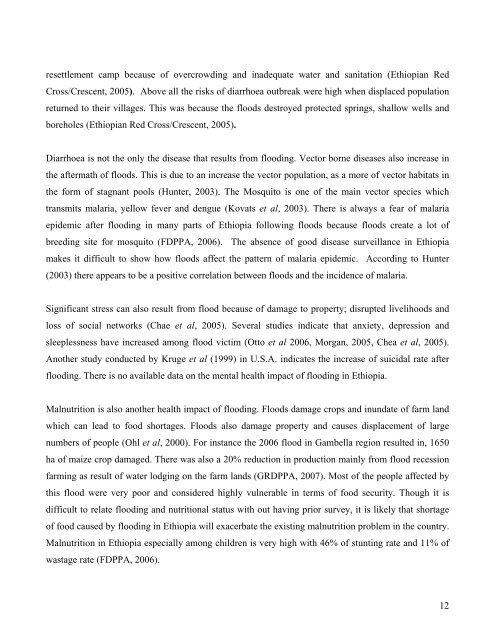Floods and Health in Gambella region, Ethiopia: An ... - lumes
Floods and Health in Gambella region, Ethiopia: An ... - lumes
Floods and Health in Gambella region, Ethiopia: An ... - lumes
You also want an ePaper? Increase the reach of your titles
YUMPU automatically turns print PDFs into web optimized ePapers that Google loves.
esettlement camp because of overcrowd<strong>in</strong>g <strong>and</strong> <strong>in</strong>adequate water <strong>and</strong> sanitation (<strong>Ethiopia</strong>n Red<br />
Cross/Crescent, 2005). Above all the risks of diarrhoea outbreak were high when displaced population<br />
returned to their villages. This was because the floods destroyed protected spr<strong>in</strong>gs, shallow wells <strong>and</strong><br />
boreholes (<strong>Ethiopia</strong>n Red Cross/Crescent, 2005).<br />
Diarrhoea is not the only the disease that results from flood<strong>in</strong>g. Vector borne diseases also <strong>in</strong>crease <strong>in</strong><br />
the aftermath of floods. This is due to an <strong>in</strong>crease the vector population, as a more of vector habitats <strong>in</strong><br />
the form of stagnant pools (Hunter, 2003). The Mosquito is one of the ma<strong>in</strong> vector species which<br />
transmits malaria, yellow fever <strong>and</strong> dengue (Kovats et al, 2003). There is always a fear of malaria<br />
epidemic after flood<strong>in</strong>g <strong>in</strong> many parts of <strong>Ethiopia</strong> follow<strong>in</strong>g floods because floods create a lot of<br />
breed<strong>in</strong>g site for mosquito (FDPPA, 2006). The absence of good disease surveillance <strong>in</strong> <strong>Ethiopia</strong><br />
makes it difficult to show how floods affect the pattern of malaria epidemic. Accord<strong>in</strong>g to Hunter<br />
(2003) there appears to be a positive correlation between floods <strong>and</strong> the <strong>in</strong>cidence of malaria.<br />
Significant stress can also result from flood because of damage to property; disrupted livelihoods <strong>and</strong><br />
loss of social networks (Chae et al, 2005). Several studies <strong>in</strong>dicate that anxiety, depression <strong>and</strong><br />
sleeplessness have <strong>in</strong>creased among flood victim (Otto et al 2006, Morgan, 2005, Chea et al, 2005).<br />
<strong>An</strong>other study conducted by Kruge et al (1999) <strong>in</strong> U.S.A. <strong>in</strong>dicates the <strong>in</strong>crease of suicidal rate after<br />
flood<strong>in</strong>g. There is no available data on the mental health impact of flood<strong>in</strong>g <strong>in</strong> <strong>Ethiopia</strong>.<br />
Malnutrition is also another health impact of flood<strong>in</strong>g. <strong>Floods</strong> damage crops <strong>and</strong> <strong>in</strong>undate of farm l<strong>and</strong><br />
which can lead to food shortages. <strong>Floods</strong> also damage property <strong>and</strong> causes displacement of large<br />
numbers of people (Ohl et al, 2000). For <strong>in</strong>stance the 2006 flood <strong>in</strong> <strong>Gambella</strong> <strong>region</strong> resulted <strong>in</strong>, 1650<br />
ha of maize crop damaged. There was also a 20% reduction <strong>in</strong> production ma<strong>in</strong>ly from flood recession<br />
farm<strong>in</strong>g as result of water lodg<strong>in</strong>g on the farm l<strong>and</strong>s (GRDPPA, 2007). Most of the people affected by<br />
this flood were very poor <strong>and</strong> considered highly vulnerable <strong>in</strong> terms of food security. Though it is<br />
difficult to relate flood<strong>in</strong>g <strong>and</strong> nutritional status with out hav<strong>in</strong>g prior survey, it is likely that shortage<br />
of food caused by flood<strong>in</strong>g <strong>in</strong> <strong>Ethiopia</strong> will exacerbate the exist<strong>in</strong>g malnutrition problem <strong>in</strong> the country.<br />
Malnutrition <strong>in</strong> <strong>Ethiopia</strong> especially among children is very high with 46% of stunt<strong>in</strong>g rate <strong>and</strong> 11% of<br />
wastage rate (FDPPA, 2006).<br />
12
















